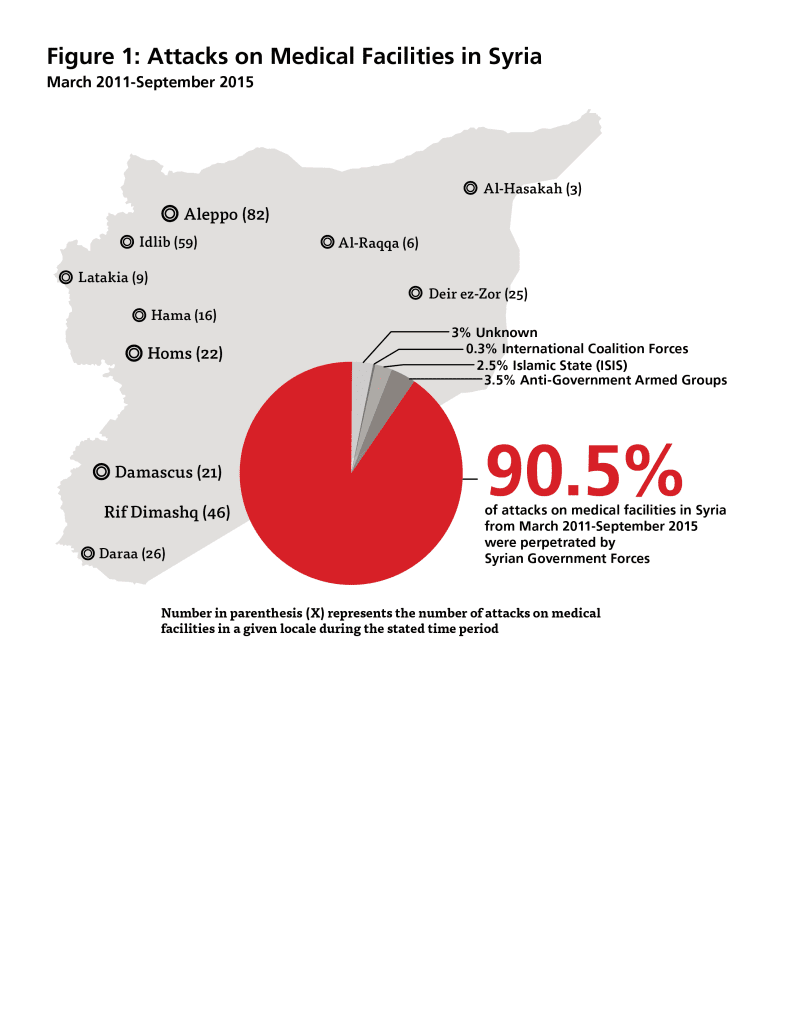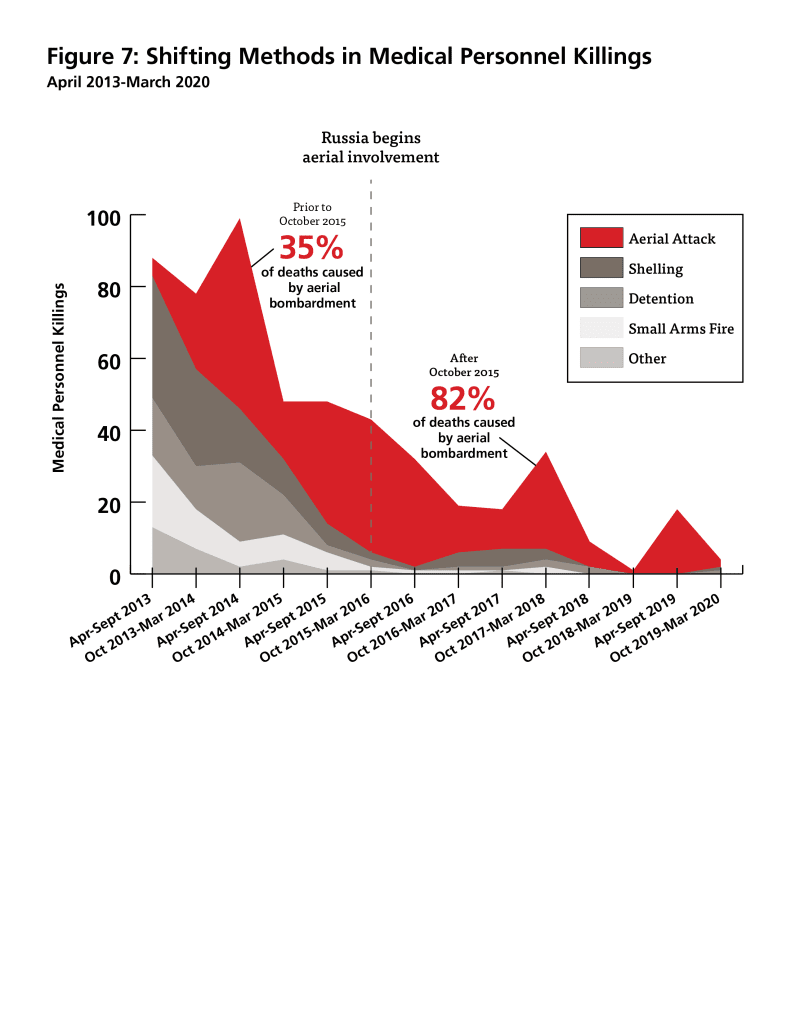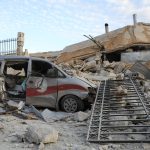Introduction
- This expert report is presented by Physicians for Human Rights (PHR) to provide the U.N. Human Rights Committee with an expert view on widespread and systematic attacks against Syria’s health care system, including the extent to which Russian forces engaged in such attacks following Russia’s formal intervention in the conflict in Syria in October 2015 and their impact on respect for Article 6 of the International Covenant on Civil and Political Rights (ICCPR or Covenant).[1]
- PHR is an international human rights organization that works at the intersection of medicine, science, and law to end human suffering, save lives, and secure justice and universal human rights for all. It was established in 1986 to use the unique skills and credibility of health professionals to advocate for persecuted health workers, prevent torture, document mass atrocities, and hold those who violate human rights accountable.
- PHR’s global network of health professionals, lawyers, and human rights researchers and activists has worked across five continents to ensure accountability for attacks on health care infrastructure and personnel and for sexual violence in conflict zones, to end torture and ill-treatment, to speak out for the right to protest safely, to halt the use of excessive force by police and security forces, and to safeguard the rights and health of asylum seekers. PHR trains health, legal, and law enforcement professionals to document evidence of human rights abuses and to work together to bring that evidence to court, hold violators accountable, and secure justice for victims and survivors. We investigate mass atrocities and advocate to protect health care facilities and personnel from attack. The evidence PHR gathers has been used by international and local justice mechanisms, United Nations bodies, policymakers, and journalists to help bring human rights abusers to justice, prosecute war crimes, reform policies and practices that undermine human rights, secure reparations for survivors, and spur action in the face of growing rights violations.
- PHR has been actively involved in documenting human rights abuses and violations of international humanitarian law (IHL) and international human rights law (IHRL) committed during the course of the conflict in Syria, with a particular focus on attacks on medical facilities and health care providers.[2] In 2011, PHR researchers began documenting attacks on Syrian health infrastructure, creating an interactive map of attacks with the purpose of documenting and visualizing attacks on health care facilities in Syria during the ongoing conflict. The map is publicly available on PHR’s website at https://syriamap.phr.org. PHR also documents attacks on medical personnel working in Syria, including unlawful detentions, ill-treatment, and the killing of health care workers. PHR has published multiple reports on this issue and has also developed a publicly available page to track the deaths of health care workers at https://phr.org/our-work/resources/medical-personnel-are-targeted-in-syria/.
- PHR’s map of attacks on health infrastructure is designed to document those attacks that either intentionally or indiscriminately damage health care facilities or workers.[3] Attacks that target a civilian object intentionally or indiscriminately are prohibited under IHL.[4] Health care facilities are [5] afforded special protection under IHL and may not be the object of attack (except under very narrow exceptions when they have been ‘militarized’). Medical personnel[6] are similarly entitled to carry out their duties impartially and without interference.[7] PHR’s map documents that the Syrian government and allied Russian forces have engaged in both intentional and indiscriminate attacks on health care facilities, in violation of IHL and IHRL, including the right to life and the right to health.
- PHR’s rigorous, original research, monitoring, and analysis of the conflict in Syria for more than a decade reflects the grave harms of attacks on health care. It has documented the killing of 949 medical professionals since March 2011, the vast majority of which can be attributed to the Syrian government and Russian forces.[8] PHR’s research has also established patterns of arrest, detention, and torture of health care workers in Syria.[9] It has published nine case studies to date documenting attacks on medical facilities throughout the country,[10] and since 2019, has closely examined the impact of attacks on civilian access to health care.[11] Most recently, PHR examined the link between conflict and diminished access to sexual and reproductive health services in northwest Syria.[12]
- This report first describes the numbers and patterns of attacks on health care in Syria and examines evidence pointing to Russia’s involvement in these attacks, which both increased and accelerated following its entry into the conflict on the Syrian government’s behalf in September 2015. The report then offers a case study of a 2021 attack on al-Atareb Hospital in western Aleppo, which killed seven patients. This attack is an example of the targeting of isolated health facilities that has been a hallmark of the Syrian conflict and the use of the “double tap” strategy by Russian forces.[13] The third section illustrates the devastating impact of these attacks on community health in Syria. The report then considers the various ways in which these attacks violate the right to life and the right to health and shows how current, continued attacks by Russia on the civilian population in Ukraine mirror the patterns observed in Syria.
Read the full report: English, Arabic, Russian



Graphic design generously contributed by Sarah Georgakopoulos.
[1] This expert report is provided to accompany a Communication submitted to the Human Rights Committee on May 1, 2024 concerning an alleged attack on a hospital in Syria – the Kafr Nabl Surgical Hospital – on May 5, 2019, by Russia. Physicians for Human Rights (PHR) hopes that this report may be of assistance to the Human Rights Committee in its consideration of the authors’ Communication.
[2] Significantly, PHR defines an “attack” more narrowly than IHL and focuses only on violent assaults upon a medical facility resulting in any destruction, damage, or loss of the facility’s function, equipment, or medical supplies. An attack can include bombing, shelling, artillery, car bombs, shooting, arson, or attack by armed personnel. “Medical facilities” refer to permanent facilities or mobile clinics used for medical purposes at the time of attack and therefore protected under IHL. For purposes this report, “health care facility” and “medical facility” are used interchangeably. See Physicians for Human Rights, “PHR Methodology for Collection of Data on Medical Facilities,” accessed April 17, 2024, https://syriamap.phr.org/#/en/methodology.
[3] See PHR, “Overview of Principles and Rules of International Humanitarian Law Applicable to Conduct of Hostilities with a Focus on Targeting of Hospitals and Medical Units,” 2012, https://s3.amazonaws.com/PHR_syria_map/ihl-methodology-appendix.pdf.
[4] See ICRC, “Rule 11: Indiscriminate attacks are prohibited,” International Humanitarian Law Databases, accessed April 2, 2024, https://ihl-databases.icrc.org/en/customary-ihl/v1/rule11; Protocol Additional to the Geneva Conventions of 12 August 1949, and relating to the Protection of Victims of International Armed Conflicts (Protocol I), December 7, 1978, Article 51. The description of “indiscriminate” targeting involves considerations beyond this report; however, under IHL, an indiscriminate attack is one that is not directed at a specific military project or that employs a “method or means of combat” which either cannot be directed at a specific military objective or the effect of which cannot be limited such they “are of nature to strike military objectives and civilians or civilian objects without distinction.” An attack that is not directed at any military objective is strictly prohibited. See e.g., ICRC “Rule 12: Definition of indiscriminate attacks,” International Humanitarian Law Databases, accessed April 2, 2024, https://ihl-databases.icrc.org/en/customary-ihl/v1/rule12; Protocol Additional I, Article 51.
[5] Protocol Additional to the Geneva Conventions of 12 August 1949, and relating to the Protection of Victims of Non-International Armed Conflicts (Protocol II), December 7, 1978, Article 51, https://ihl-databases.icrc.org/en/ihl-treaties/apii-1977/article-11.
For the limited exceptions to this rule, see ICRC, “Rule 25: Medical Personnel,” International Humanitarian Law Databases, accessed April 17, 2024, https://ihl-databases.icrc.org/en/customary-ihl/v1/rule25. PHR’s map excludes Syrian hospitals or clinics that the data show may have been militarized or used for military purposes.
[6] Medical personnel include any individual involved in the provision of health care such as physicians, nurses, technicians, dentists, pharmacists, ambulance drivers, non-professionally trained medical volunteers, and other hospital staff. Additional Protocol I, Article 8(c); ICRC, “Rule 25.”
[7] Common Article Three states “[t]he wounded and sick shall be collected and cared for.” Geneva Convention (IV) relative to the Protection of Civilian Persons in Time of War, October 21, 1950, Article 3, https://ihl-databases.icrc.org/en/ihl-treaties/gciv-1949/article-3.
[8] PHR, “Medical Personnel Are Targeted in Syria,” last modified February 2024, https://phr.org/our-work/resources/medical-personnel-are-targeted-in-syria/.
[9] See, e.g., PHR, “My Only Crime Was That I Was a Doctor,” December 2019, https://phr.org/our-work/resources/my-only-crime-was-that-i-was-a-doctor/; PHR, “The Survivors, the Dead, and the Disappeared: Detention of Health Care Workers in Syria, 2011-2012,” November 2021, https://phr.org/our-work/resources/the-survivors-the-dead-and-the-disappeared/?utm_source=website_promo.
[10] See, e.g., “No Place Is Safe for Health Care – The Attack on Syria’s Al-Atareb Hospital”; “At Syria’s Cave Hospital”; “Conducting Surgery under Bombardment and Siege; Al-Quds Hospital – The Last Hospital Standing in Aleppo”; “Kafr Nabl Hospital – in the crosshairs of a murderous barrage of attacks”; “The Destruction of Hospitals – A Strategic Component in Regime Military Offensives”; “Repeated attacks on underground medical facility demonstrate deliberate targeting”; “Attacking Health Care with Chemical Agents; Three Attacks in One Day”; “Heavy Bombardment by U.S. and Coalition Forces Devastate Hospitals in Raqqa.” All of these PHR case studies are available at PHR, “Case Studies,” accessed April 17, 2024, http://syriamap.phr.org/#/en/case-studies/.
[11] See, e.g., PHR, “The Syrian Conflict: Eight Years of Devastation and Destruction of the Health System,” March 2019, https://phr.org/our-work/resources/the-syrian-conflict-eight-years-of-devastation-and-destruction-of-the-health-system/; PHR, “Obstruction and Denial: Health System Disparities and COVID-19 in Daraa, Syria,” December 2020, https://phr.org/our-work/resources/obstruction-and-denial-health-system-disparities-and-covid-19-in-daraa-syria/; PHR, “Destruction, Obstruction, and Inaction: The Makings of a Health Crisis in Northern Syria,” December 2021, https://phr.org/our-work/resources/syria-health-disparities/.
[12] PHR, “She Pays the Highest Price: The Toll of Conflict on Sexual and Reproductive Health in Northwest Syria,” March 14, 2023, https://phr.org/our-work/resources/sexual-and-reproductive-health-in-northwest-syria/.
[13] As discussed further below, the “double tap” strategy refers to bombing a target multiple times in relatively quick succession, so the subsequent strikes often hit those responding to the first attack.

